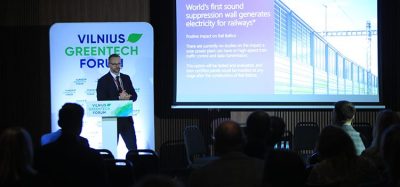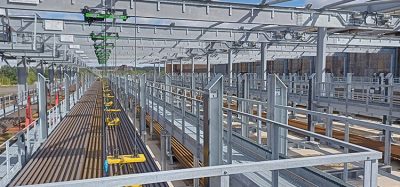Major network investments will help reduce UK passenger disruption
Posted: 12 December 2009 | | 1 comment
If a railway network is in need of track renewal, it is vitally important that the procedures are carried out to the best possible standards. Network downtime needs to be kept to an absolute minimum and it is therefore essential for infrastructure owners to invest heavily in high-tech track renewal technology and machinery.
If a railway network is in need of track renewal, it is vitally important that the procedures are carried out to the best possible standards. Network downtime needs to be kept to an absolute minimum and it is therefore essential for infrastructure owners to invest heavily in high-tech track renewal technology and machinery.
If a railway network is in need of track renewal, it is vitally important that the procedures are carried out to the best possible standards. Network downtime needs to be kept to an absolute minimum and it is therefore essential for infrastructure owners to invest heavily in high-tech track renewal technology and machinery.
Network Rail, the owner and operator of Britain’s railway infrastructure, performs work to tracks, signals, tunnels, viaducts, level crossings and stations. Network Rail aims to provide a safe, reliable and efficient network for freight and passenger trains, fit for the 21st century. It is with this in mind that they have recently announced a major commitment to achieve their own goals.
Network Rail passengers are set to reap the benefits as the infrastructure owner continues its investment in high-tech track renewals technology. This investment will ensure that disruption to the network is significantly reduced as the high-output technology will be capable of carrying out track renewal tasks much quicker than conventional methods.
At the end of September 2009, Network Rail announced AmeyColas as its preferred bidder for a new contract to operate and maintain its fleet of high-tech, high-output track renewal systems. Over the next few years, Network Rail will be increasing the work it carries out at night, which will contribute to less disruption and make the network more available for passengers.
The contract for this is worth approximately £250 million and will see more than 1,600 miles of track – which is nearly 30% of Network Rail’s total renewal workload – renewed and replaced over the next four years, with an estimated £85 million in cost savings identified.
Network Rail currently operates three high-output systems consisting of high-output ballast cleaners (which renew ballast to maintain a smooth ride) high-output track renewals trains and other support machinery and plant. The company is expecting delivery of its fourth high-output system in December 2010.
With modern machinery and efficient automation methods, Network Rail’s high-output systems can replace between 400m-600m of track and ballast within eight hours – significantly reducing costs and disruption to passengers and freight users.
Network Rail’s Director of Infrastructure Investment, Simon Kirby, recently said: “We are committed to delivering a high-performance railway for passengers and freight users. Technological innovation combined with commercial rigour is key to securing this.”
The contract will be set up under a framework agreement with annual packages of work awarded for the operation and maintenance of each high-output system. The framework creates incentives to improve performance and increase efficiences that deliver the targets set out by the Office of Rail Regulation (ORR). The contract is due to start on 1 January 2010.
In total, the framework contract will cover four separate high-output systems – each with its own geographical base. Network Rail’s high-output fleet includes:
- System 1: 2 ballast cleaning systems
- System 2: 1 high-output ballast cleaning systems, 1 high-output track renewal system and support plant
- System 3: 1 high-output ballast cleaning system and support plant
- System 4: (which delivery is expected towards the end of 2010) includes 1 high-output ballast cleaning system, 1 high-output track renewal system and support plant
The framework replaces existing contracts for operation and maintenance of the before-mentioned System 2 and System 3 with First Swietelsky, and operation of System 1 with Fastline – both of which have reached the end of their contract period.
With continuous efforts and major investments into performing important track work just like this, Network Rail are ensuring that the countries rail network is safe and reliable – an achievement to win passengers from road transport to rail.
Other important milestones
Track renewal completes the picture at Nelson
Following completion of a brand new bus/rail interchange and a completely refurbished station platform canopy, Network Rail’s maintenance teams have completed the picture at Nelson railway station in East Lancashire by completely re-laying the track through the station.
Network Rail’s Route Director Jo Kaye explained: “There is only a single line through Nelson station so we did not have the luxury of being able to bring all the equipment and materials in on one line while we worked on the other, as is usual. Added to this, the line is on a curve and we were working right up against the platform, part of which goes over a road bridge. Thanks to our maintenance people from various depots in Lancashire and Cheshire we delivered the project on time.”
The work was carried out over two Sundays and involved up to 16 people per shift taking up the rails and sleepers so the track bed could be dug out. The stones that form the base for the track had become contaminated over the years and needed to be replaced.
Using a variety of specialist road/rail equipment, a total of 720 tonnes of new stone was brought in and a laser guided bulldozer was used to get the right levels for the curved track. The actual rails through the station were in a good condition and did not need replacing, so they were attached to new wooden sleepers using new base plates and clips.
This £103,000 project adds to the £4.5m spent on the interchange and the £200,000 investment in the canopy refurbishment.
£1.5 million investment in Cross City Line
In October 2009, work started on a £1.5 million upgrade to the track on the Cross City Line south. Passengers will benefit from five miles of new track giving a smoother ride and less disruption from maintenance in the future.
The planned renewals are taking place over 11 weeks at Northfield, Selly Oak and Longbridge. The majority of the work is being undertaken at weekends and weekday nights to cause minimum disruption to the travelling public. Work started on 13 September at Selly Oak and will finish on 22 November with the final pieces of track being replaced at Northfield.
Jo Kaye, Route Director said: “The Cross City Line is a hugely important route for Birmingham and keeping the track well maintained and trains running are vitally important for the city’s economy. Working through the night and all day on Sundays means that we can keep the city moving through the week whilst these important renewals take place.”
Network Rail uses large machinery as well as an army of up to 60 at a time to remove the old track and sleepers, replace the concrete sleepers and lengths of rail and pack it with stone.
Passengers to benefit from £21 million ‘Green’ revolution on the Boston to Skegness line
Passengers on the Boston to Skegness line are set to benefit from a £21 million injection of new track on the route. The overall project will see 32 miles of track replaced using recycled materials making the railways even greener.
The work started on Friday 2 October 2009 to replace the first 12 miles and at the time of writing this is due to finish by 2 November 2009.
Richard Lungmuss, Route Director said: “This is a groundbreaking project that will deliver huge benefits to the thousands of people who use this route. We are using recycled materials on an unprecedented scale that will result in massive amounts of track replaced in an incredible short timescale at a very affordable price.”
The track between Boston and Skegness was opened in 1873 and has suffered from years of underinvestment. It is an important line for both the local community and visitors to the area and this work will give a new lease of life to the route.
Phase one of work will see the line between Boston and Skegness closed for four weeks. Engineers will work round the clock to replace 21,000 yards of track using only recycled and serviceable materials from other parts of the network.
The final 35,000 yards of track will be replaced during the second and third phases of this work which will take place in 2010 and 2011.
Included in this work, Network Rail will be using:
- 86,000 concrete sleepers
- 132,000 yards of rail
- 140,000 tonnes of ballast
Included in this work, Network Rail will be reusing:
- 23,650 tonnes of concrete
- 120,000 tonnes of ballast
- 6,700 tonnes of steel
The benefits to passengers of this project, includes:
- A much smoother ride due to change from jointed track to continuously welded rail which can be installed in longer lengths
- Access for different types of trains – giving more capacity at busy times
- Faster trains and shorter journey times – speed restrictions will be removed
- Less disruption due to maintenance work
Network Rail is using 100% recycled materials – rail, sleepers and ballast, involving an 18 month national material recovery and delivery programme on the biggest scale seen in the UK since the 1960s.







